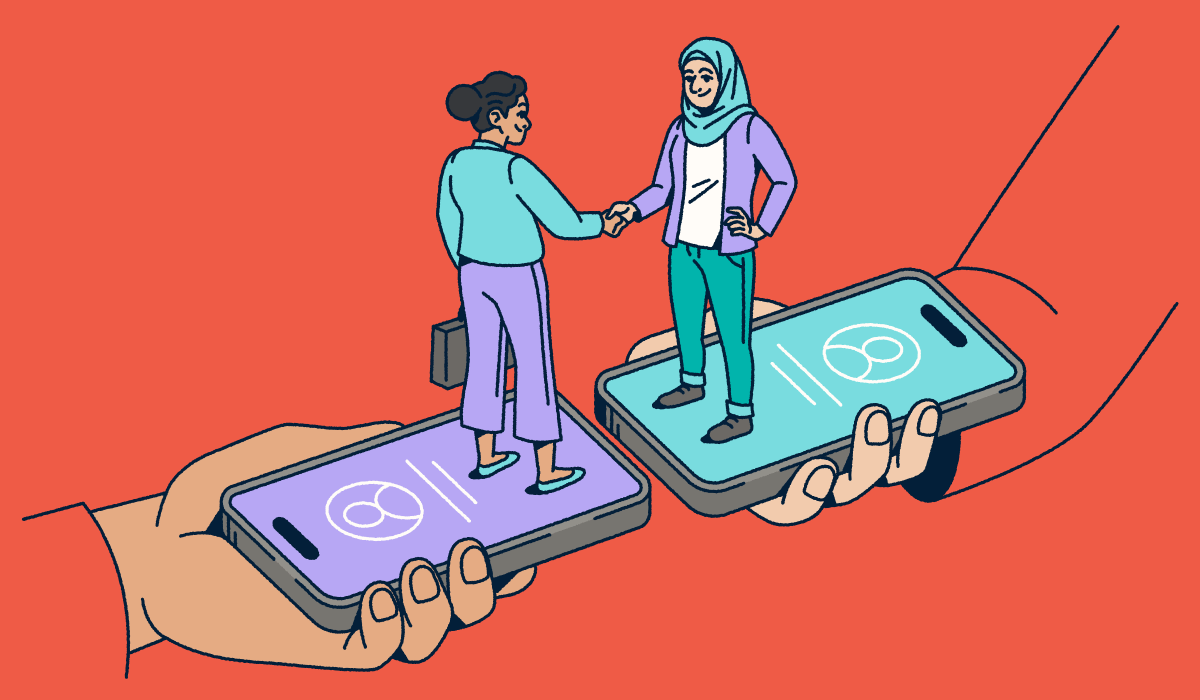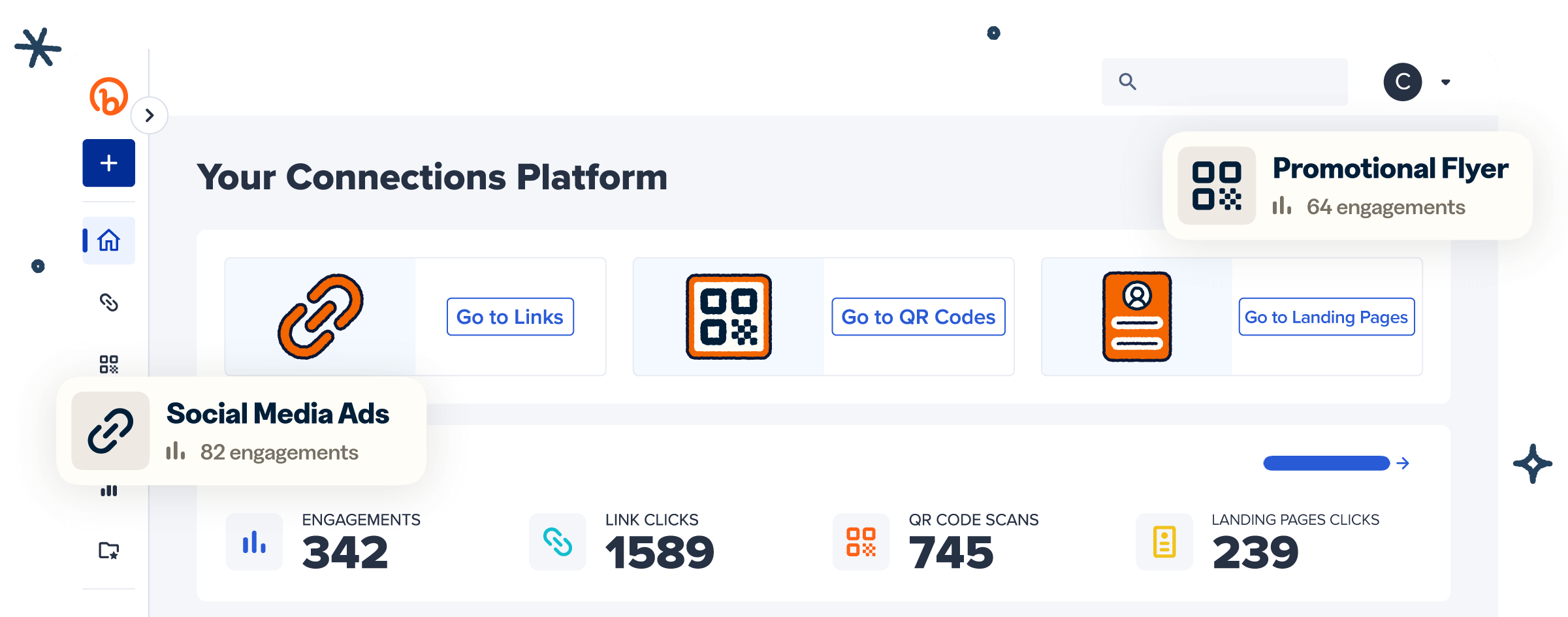You’re at a conference, chatting with someone you actually want to follow up with—and just like that, your last paper business card is gone. Sound familiar? That’s exactly the kind of moment digital business cards are built for.
These mobile-first alternatives are quickly gaining traction among professionals, teams, and businesses looking to modernize how they connect in the digital age. Instead of fumbling for a card, you can share your contact info with a quick QR Code scan or text.
But while digital business cards offer convenience, customization, and more sustainable networking, they’re not the perfect fit for every situation. Here, we’ll explore what digital business cards are, weigh their pros and cons, and help you decide if they’re the right choice for your networking strategy.
Note: The brands and examples discussed below were found during our online research for this article.
What is a digital business card?
A digital business card (also called a virtual business card) is a modern, mobile-friendly alternative to traditional business cards. They’re typically shared via Quick Response (QR) Codes, near-field communication (NFC), apps, or clickable links (via SMS or WhatsApp), and they don’t require any printing.
Unlike paper business cards that can be lost, tossed, or become outdated, digital versions are always accessible, easily shareable, and can be updated in real time.
Professionals across industries—from small business owners and remote workers to sales teams and startups—use these digital solutions to simplify networking, create a strong first impression, and make lasting personal connections.
Pros of digital business cards
Virtual cards offer a modern, efficient alternative to paper, so they’re especially useful for professionals looking to streamline their networking while cutting costs and waste. Just take a look at these benefits of digital business cards to see why so many people are making the switch.
Convenient and shareable
At a busy conference or networking event, the last thing you want is to fumble through your bag or wallet for that last crumpled business card. With digital cards, sharing your contact details is instant and stress-free.
A quick QR Code scan or tap of a link in an email or text message is all it takes to share your info with a new contact or potential client. No running out of cards. No losing them in your coat pocket. Just seamless, on-the-spot connections that keep the conversation moving forward.
Cost-effective and eco-friendly
Going digital eliminates printing costs, saving you money on design, production, and inevitable reprinting. It’s a simple way to cut expenses without sacrificing professionalism.
It also supports your sustainability goals. By removing paper from the equation, you reduce waste and lessen your overall environmental impact. Instead of contributing to the pile of business cards that end up in the trash or forgotten in drawers, digital cards offer a high-quality, budget-friendly solution that’s better for both your wallet and the planet.
Customizable and dynamic
With digital business cards, updating your details is as simple as a few taps. Did you change your phone number? Get a new job title? Update your company name or add more social media platforms?
No need to reprint—just make the updates, and your new card is instantly ready to share. This flexibility helps you keep your contact info accurate and your branding consistent, no matter how often things change.
If you’re creating a Bitly digital business card, you can build it on a branded landing page using a Bitly Pages template, then share it via a Bitly Code or Bitly Link. The best part? You can update your card details in real time and keep using the same QR Code or short link for sharing.
Engagement tracking and data insights
A digital card doesn’t just share your contact details—it can also show you how it’s performing. Some platforms, including Bitly, provide digital business card analytics, letting you track how often your card is scanned, where those scans are coming from, and even the devices used.
With Bitly Pages, Links, and Codes, you get data on:
- Total views, scans, and clicks
- Views, scans, and clicks over time
- Referrer
- Device used (iOS/Android, mobile/desktop)
- Scans and clicks by location (city/country level)
This data provides a clear picture of how your networking efforts are performing, allowing you to refine outreach strategies and better understand your target audience. By adjusting your approach based on peak time periods or specific regions, you can ensure your networking efforts are always on target.
Easier to store and organize
Gone are the days of digging through a drawer or wallet full of outdated or crumpled business cards. Digital cards live in your phone contacts, apps, or email folders, making them easily accessible whenever you need them.
Multimedia integration
One of the standout advantages of digital business cards is their ability to seamlessly incorporate multimedia elements, making them more interactive and informative than their traditional counterparts. You can embed links to your website and social media profiles or showcase videos and images highlighting your work.
Whether it’s a portfolio, a promotional video, or easy access to your LinkedIn profile, multimedia integration helps you create a richer connection and leave a lasting impression in today’s digital world.
Are paper business cards still relevant?
With all the benefits of digital cards, you’re probably wondering if paper business cards are worth investing in at all. Short answer? Yes and no.
Despite the rise of digital alternatives, traditional paper business cards still matter, particularly in industries where face-to-face networking and long-standing customs are the norm. Paper cards can feel more personal, making them useful for building rapport in formal or relationship-driven settings.
They’re also helpful in regions with limited internet access or for professionals who prefer low-tech tools. In fact, 57% of business owners still consider physical business cards essential to their marketing, and with around 7–10 billion cards printed annually in the US, they’re clearly not obsolete.
So, before you go all-in on digital, take a look at these potential downsides of digital business cards and evaluate whether a hybrid approach might be the better choice for your needs.
Cons of digital business cards
Even with all the advantages of digital business cards, they’re not perfect for every interaction. In more traditional or tech-limited environments, a physical card may still carry more weight. Here are a few situations where digital cards can fall short—and how to work around them.
The need for a device and Internet connection
Digital business cards require both parties to have a smartphone and internet access. That can pose a challenge in areas with spotty service or when networking with individuals who aren’t as comfortable with mobile tech.
Without the right device or a stable connection, exchanging digital cards can be difficult, making paper business cards a helpful backup in certain situations.
Perceived informality in some settings
In industries like law, finance, or executive-level business, face-to-face interaction and paper cards are still the standard. A digital card may feel too casual or impersonal in contexts where a formal exchange helps build trust.
Take the legal field, for instance. Lawyers often rely on traditional networking practices. A paper business card, exchanged in person, reinforces professionalism and attention to detail. In these environments, a digital-only approach may not meet the expectations of more traditional professionals who value a personal touch.
Adoption curve for certain audiences
While digital business cards are easy to use for most, not everyone is eager to adopt new technology. Some people—especially those used to traditional methods—may be unsure how to scan a QR Code or may simply prefer the tactile experience of exchanging paper cards.
Older professionals or those in less tech-forward industries may need more time to warm up to digital networking tools, especially if the process feels unintuitive or outside their comfort zone.
Pro tip: Want the best of both worlds? Create a QR Code that links to your digital business card and add it to your paper business cards. You get the polished feel of a physical card with the convenience, multimedia integrations, and tracking benefits of a digital one.
Create an easily accessible digital business card with Bitly
Digital business cards are changing how professionals connect, offering a sleek, modern alternative that’s easier to share, customize, and keep up to date. They help cut costs, reduce waste, and make networking more efficient in a digital-first world.
Bitly makes it easy to create a digital business card that works harder for you. With Bitly Pages, you can design a branded landing page that showcases your contact information, social media profiles, and key links—all in one place.
Pair it with a Dynamic QR Code or a custom short link to easily share it with new connections, whether in person or online. Then, use Bitly Analytics to track scans and clicks for real-time insights into how and where your card is being used.
Ready to elevate your networking strategy? Sign up for a Bitly account and create your digital business card today.




